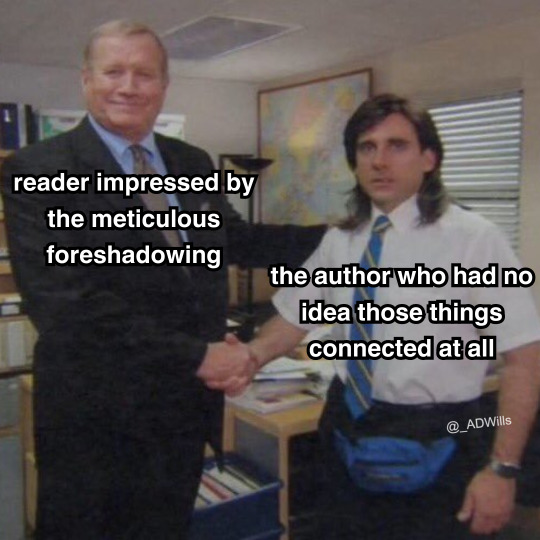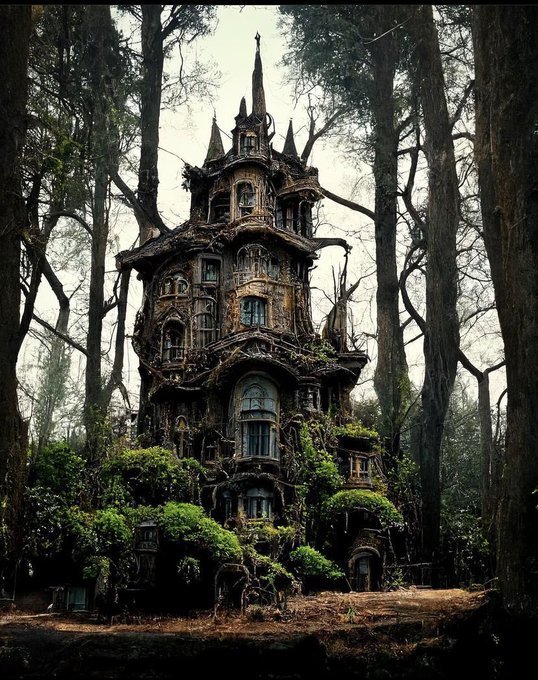Text

@nestaarcheronweek | Day 01: Queen of Queens
“We heard about you down here. You are the one the sea and the wind and the earth whispered of.”
“Nesta.”
“You took from the Cauldron itself.”
“Come with me, Queen of Queens, and we shall return what was once lost.”
- Chapter 54, A Court of Silver Flames.
Nesta has been referenced more than once as a queen in the books, and perhaps this is a portent for what the future holds for her. Maybe not exactly as queen, but as ruler of the Dusk Court.
In this art, me and Luana wanted to represent Nesta as it's High Lady, holding her two swords: Cauldron made Ataraxia and Starsword/Gwydion. And we couldn't have loved more how @gessueter brought this idea to life.
Art by: @gessueter
Commissioned by: @melphss and Luana
Characters belongs to: Sarah J. Maas
1K notes
·
View notes
Text
🤣 now I'll never be able to unsee it

Someone on Reddit mentioned the boys carrying people w their toes, like birds. So.
(Also he’s gripping Lucien’s hair to keep it from whipping against him.)
161 notes
·
View notes
Photo

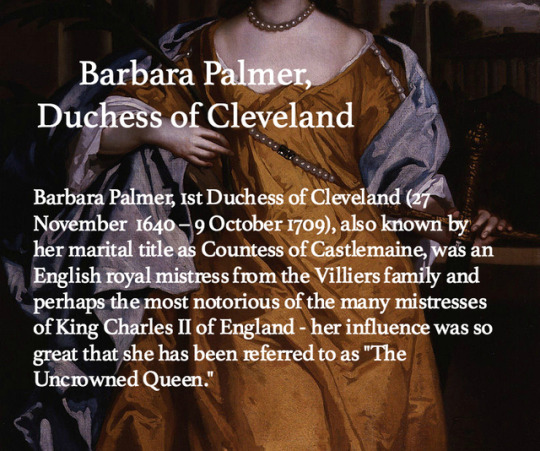
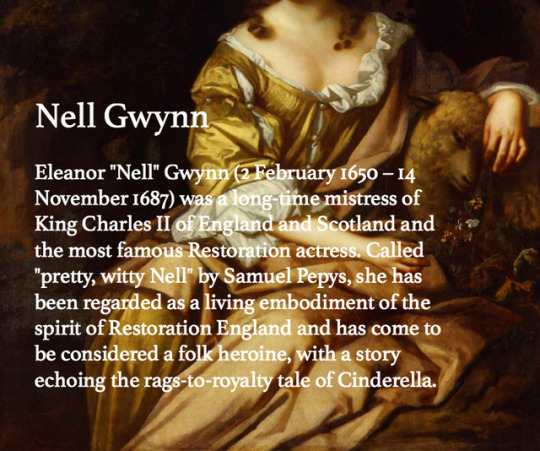

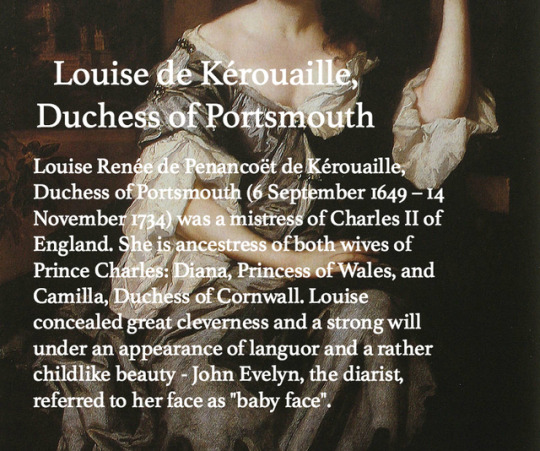

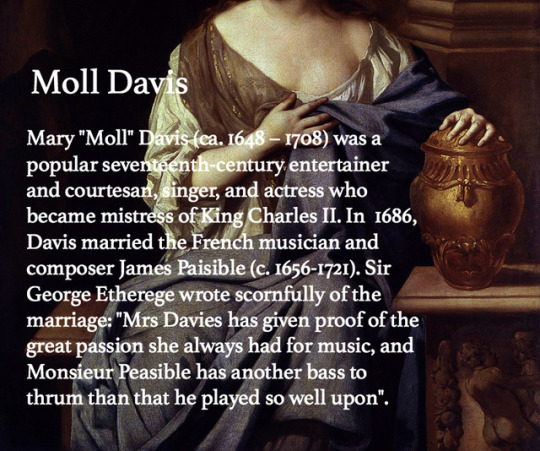
Women in History | The Remarkable Mistresses of Charles II
Certainly, the Restoration period was optimistic, vigorous, exciting. But apart from lovely dresses, did things get better for women? Of course, history doesn’t work in straight lines, and the answer is yes… and no. The potential rewards for being one of Charles II’s “harlots” were considerable. You could win enormous political influence, a dukedom for your children, financial security. You might even, like Barbara Villiers, end up with Hampton Court Palace as a retirement home. She was powerful enough to depose a government minister like the Earl of Clarendon, and self-confident enough to be unfaithful even to the king. It’s fun to imagine the tables being turned on Charles II, so well known for cutting a swath through the beauties of his court and consuming women like a combine harvester. And yet, he deserves some feminist credit. This king who loved women also respected them. For the first time, we find his female favourites becoming companions and advisers as well as playmates. (x)
354 notes
·
View notes
Photo

(ACOTAR CHARACTERS) - AMREN
“ I heard you grew fangs in the forest and killed some Hybern beasts. GOOD FOR YOU, GIRL“
133 notes
·
View notes
Text
it’s so fucked up that they just demolish buildings instead of taking them apart piece by piece. how are you going to sort that into recycling, compost, and trash ❓🤨Plus i could have used that beautiful brick wall
2K notes
·
View notes
Text
I wish for Palestinians to have ordinary days without artillery and i want them to eat their cuisine in peace on a mundane morning. I want their children to go to school and i want them to go to work in peace in their own damn fucking country and their own damn fucking land. It's all theirs. It will never be Isntreal.
15K notes
·
View notes
Text
think it's a deep consolation to know that spiders dream, that monkeys tease predators, that dolphins have accents, that lions can be scared silly by a lone mongoose, that otters hold hands, and ants bury their dead. that there isn't their life and our life. nor your life and my life. that it's just one teetering and endless thread and all of us, all of us, are entangled w it as deep as entanglement goes. v neat i think.
73K notes
·
View notes
Text
I'm a huge proponent of sharing skills and knowledge, particularly of the how to do things for yourself variety. And when I share these with others I try to do so in a non judgemental way. A phrase I use a lot is "If no one taught you, how would you know?" And I mean it in the most genuine way. I understand that there are a lot things people just aren't taught anymore and I strongly feel that it is unfair to judge people for not knowing skills they were never taught.
All that to say one of my coworkers came in yesterday and asked how bad it was to drive with a flat tire. My immediate reaction was !!!! because it can lead to damage that's very costly especially given that a fix, even a temporary one, is relatively easy most of the time.
So I told my coworker I can help as I have a pack that supplies compressed air, can jump start a car, and has USB charging ports. (If you don't have one I highly recommend it. I got mine on sale for about $40 and it's come in handy more times than I can count.)
I asked what their tire pressure should be and they weren't sure. No problem, let me show you how to find that information. (There's a sticker inside the driver side door that lists front, rear, and spare tire pressure.) Then I walked my coworker through attaching the hose, how to set the pack to the appropriate number, and from there it just runs. It has a nice digital display and stops when it reaches the set air pressure. Very easy.
When we came back inside another coworker said they thought their tires might need air but wasn't sure. I took them out and explained how to find what their tires should be at and how to use a tire pressure gauge. We did end up putting air in one of the tires.
Back inside a third coworker admitted they had a tire that definitely needs air but they were embarrassed to get it fixed. So I went through showing them everything and filling their tire. This coworker told me their dad had told them how to do all this but the advice was hard to listen to. And I responded that I'm always happy to help. What I wanted to say is that I'm happy to explain things in a friendly way because things taught when the learner is made to feel like shit rarely stick in a helpful way. But that's too heavy for a light learning experience.
At the end of the day a different coworker started to complain to me about how younger people (they and I have about a decade on the majority of our coworkers) don't know how to help themselves. And I did my best to spin it as yes it's a shame they weren't taught these skills but fortunately you and I know them and are able to share them going forward. This stumped them for a bit before they eventually agreed with me.
I don't really have a neat way to wrap up this post. So I'm just going to reiterate that I'm always happy to pass along knowledge, provide assistance where I am able to, and ultimately help people help themselves in the areas I can.
25 notes
·
View notes
Text
“She stays lost in the middle of her own world somewhere. We can’t get in and she doesn’t come out.”
— Malorie Blackman, Noughts and Crosses
13K notes
·
View notes
Text
Words for Skin Tone | How to Describe Skin Color
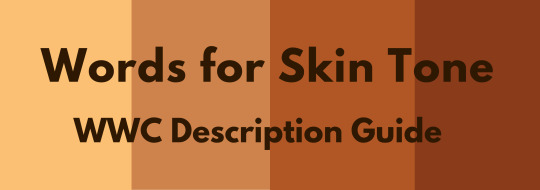
We discussed the issues describing People of Color by means of food in Part I of this guide, which brought rise to even more questions, mostly along the lines of “So, if food’s not an option, what can I use?” Well, I was just getting to that!
This final portion focuses on describing skin tone, with photo and passage examples provided throughout. I hope to cover everything from the use of straight-forward description to the more creatively-inclined, keeping in mind the questions we’ve received on this topic.
Standard Description
Basic Colors

Pictured above: Black, Brown, Beige, White, Pink.
“She had brown skin.”
This is a perfectly fine description that, while not providing the most detail, works well and will never become cliché.
Describing characters’ skin as simply brown or beige works on its own, though it’s not particularly telling just from the range in brown alone.
Complex Colors
These are more rarely used words that actually “mean” their color. Some of these have multiple meanings, so you’ll want to look into those to determine what other associations a word might have.

Pictured above: Umber, Sepia, Ochre, Russet, Terra-cotta, Gold, Tawny, Taupe, Khaki, Fawn.
Complex colors work well alone, though often pair well with a basic color in regards to narrowing down shade/tone.
For example: Golden brown, russet brown, tawny beige…
As some of these are on the “rare” side, sliding in a definition of the word within the sentence itself may help readers who are unfamiliar with the term visualize the color without seeking a dictionary.
“He was tall and slim, his skin a russet, reddish-brown.”
Comparisons to familiar colors or visuals are also helpful:
“His skin was an ochre color, much like the mellow-brown light that bathed the forest.”
Modifiers
Modifiers, often adjectives, make partial changes to a word.The following words are descriptors in reference to skin tone.
Dark - Deep - Rich - Cool
Warm - Medium - Tan
Fair - Light - Pale
Rich Black, Dark brown, Warm beige, Pale pink…
If you’re looking to get more specific than “brown,” modifiers narrow down shade further.
Keep in mind that these modifiers are not exactly colors.
As an already brown-skinned person, I get tan from a lot of sun and resultingly become a darker, deeper brown. I turn a pale, more yellow-brown in the winter.
While best used in combination with a color, I suppose words like “tan” “fair” and “light” do work alone; just note that tan is less likely to be taken for “naturally tan” and much more likely a tanned White person.
Calling someone “dark” as description on its own is offensive to some and also ambiguous. (See: Describing Skin as Dark)
Undertones
Undertones are the colors beneath the skin, seeing as skin isn’t just one even color but has more subdued tones within the dominating palette.
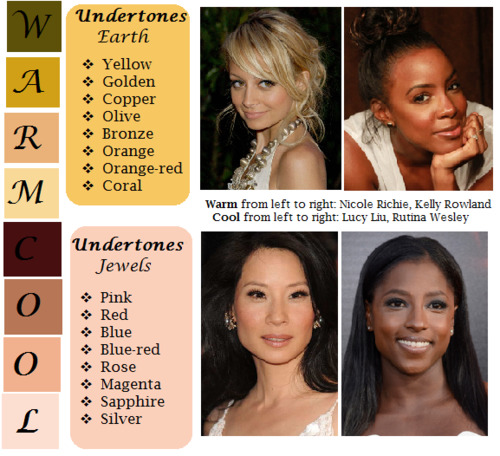
pictured above: warm / earth undertones: yellow, golden, copper, olive, bronze, orange, orange-red, coral | cool / jewel undertones: pink, red, blue, blue-red, rose, magenta, sapphire, silver.
Mentioning the undertones within a character’s skin is an even more precise way to denote skin tone.
As shown, there’s a difference between say, brown skin with warm orange-red undertones (Kelly Rowland) and brown skin with cool, jewel undertones (Rutina Wesley).
“A dazzling smile revealed the bronze glow at her cheeks.”
“He always looked as if he’d ran a mile, a constant tinge of pink under his tawny skin.”
Standard Description Passage
“Farah’s skin, always fawn, had burned and freckled under the summer’s sun. Even at the cusp of autumn, an uneven tan clung to her skin like burrs. So unlike the smooth, red-brown ochre of her mother, which the sun had richened to a blessing.”
-From my story “Where Summer Ends” featured in Strange Little Girls
Here the state of skin also gives insight on character.
Note my use of “fawn” in regards to multiple meaning and association. While fawn is a color, it’s also a small, timid deer, which describes this very traumatized character of mine perfectly.
Though I use standard descriptions of skin tone more in my writing, at the same time I’m no stranger to creative descriptions, and do enjoy the occasional artsy detail of a character.
Creative Description
Whether compared to night-cast rivers or day’s first light…I actually enjoy seeing Characters of Colors dressed in artful detail.
I’ve read loads of descriptions in my day of white characters and their “smooth rose-tinged ivory skin”, while the PoC, if there, are reduced to something from a candy bowl or a Starbucks drink, so to actually read of PoC described in lavish detail can be somewhat of a treat.
Still, be mindful when you get creative with your character descriptions. Too many frills can become purple-prose-like, so do what feels right for your writing when and where.
Not every character or scene warrants a creative description, either. Especially if they’re not even a secondary character.
Using a combination of color descriptions from standard to creative is probably a better method than straight creative. But again, do what’s good for your tale.
Natural Settings - Sky
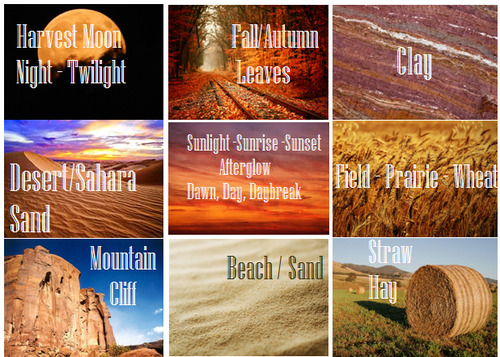
Pictured above: Harvest Moon -Twilight, Fall/Autumn Leaves, Clay, Desert/Sahara, Sunlight - Sunrise - Sunset - Afterglow - Dawn- Day- Daybreak, Field - Prairie - Wheat, Mountain/Cliff, Beach/Sand/Straw/Hay.
Now before you run off to compare your heroine’s skin to the harvest moon or a cliff side, think about the associations to your words.
When I think cliff, I think of jagged, perilous, rough. I hear sand and picture grainy, yet smooth. Calm. mellow.
So consider your character and what you see fit to compare them to.
Also consider whose perspective you’re describing them from. Someone describing a person they revere or admire may have a more pleasant, loftier description than someone who can’t stand the person.
“Her face was like the fire-gold glow of dawn, lifting my gaze, drawing me in.”
“She had a sandy complexion, smooth and tawny.”
Even creative descriptions tend to draw help from your standard words.
Flowers
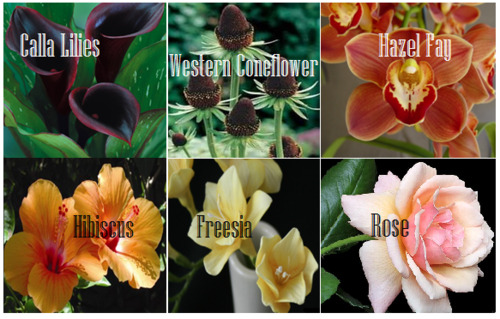
Pictured above: Calla lilies, Western Coneflower, Hazel Fay, Hibiscus, Freesia, Rose
It was a bit difficult to find flowers to my liking that didn’t have a 20 character name or wasn’t called something like “chocolate silk” so these are the finalists.
You’ll definitely want to avoid purple-prose here.
Also be aware of flowers that most might’ve never heard of. Roses are easy, as most know the look and coloring(s) of this plant. But Western coneflowers? Calla lilies? Maybe not so much.
“He entered the cottage in a huff, cheeks a blushing brown like the flowers Nana planted right under my window. Hazel Fay she called them, was it?”
Assorted Plants & Nature

Pictured above: Cattails, Seashell, Driftwood, Pinecone, Acorn, Amber
These ones are kinda odd. Perhaps because I’ve never seen these in comparison to skin tone, With the exception of amber.
At least they’re common enough that most may have an idea what you’re talking about at the mention of “pinecone."
I suggest reading out your sentences aloud to get a better feel of how it’ll sounds.
"Auburn hair swept past pointed ears, set around a face like an acorn both in shape and shade.”
I pictured some tree-dwelling being or person from a fantasy world in this example, which makes the comparison more appropriate.
I don’t suggest using a comparison just “cuz you can” but actually being thoughtful about what you’re comparing your character to and how it applies to your character and/or setting.
Wood

Pictured above: Mahogany, Walnut, Chestnut, Golden Oak, Ash
Wood can be an iffy description for skin tone. Not only due to several of them having “foody” terminology within their names, but again, associations.
Some people would prefer not to compare/be compared to wood at all, so get opinions, try it aloud, and make sure it’s appropriate to the character if you do use it.
“The old warlock’s skin was a deep shade of mahogany, his stare serious and firm as it held mine.”
Metals

Pictured above: Platinum, Copper, Brass, Gold, Bronze
Copper skin, brass-colored skin, golden skin…
I’ve even heard variations of these used before by comparison to an object of the same properties/coloring, such as penny for copper.
These also work well with modifiers.
“The dress of fine white silks popped against the deep bronze of her skin.”
Gemstones - Minerals
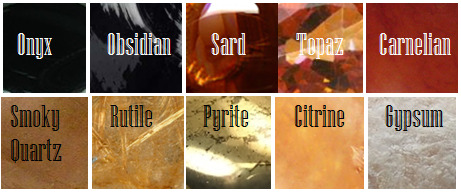
Pictured above: Onyx, Obsidian, Sard, Topaz, Carnelian, Smoky Quartz, Rutile, Pyrite, Citrine, Gypsum
These are trickier to use. As with some complex colors, the writer will have to get us to understand what most of these look like.
If you use these, or any more rare description, consider if it actually “fits” the book or scene.
Even if you’re able to get us to picture what “rutile” looks like, why are you using this description as opposed to something else? Have that answer for yourself.
“His skin reminded her of the topaz ring her father wore at his finger, a gleaming stone of brown, mellow facades.”
Physical Description
Physical character description can be more than skin tone.
Show us hair, eyes, noses, mouth, hands…body posture, body shape, skin texture… though not necessarily all of those nor at once.
Describing features also helps indicate race, especially if your character has some traits common within the race they are, such as afro hair to a Black character.
How comprehensive you decide to get is up to you. I wouldn’t overdo it and get specific to every mole and birthmark. Noting defining characteristics is good, though, like slightly spaced front teeth, curls that stay flopping in their face, hands freckled with sunspots…
General Tips
Indicate Race Early: I suggest indicators of race be made at the earliest convenience within the writing, with more hints threaded throughout here and there.
Get Creative On Your Own: Obviously, I couldn’t cover every proper color or comparison in which has been “approved” to use for your characters’ skin color, so it’s up to you to use discretion when seeking other ways and shades to describe skin tone.
Skin Color May Not Be Enough: Describing skin tone isn’t always enough to indicate someone’s ethnicity. As timeless cases with readers equating brown to “dark white” or something, more indicators of race may be needed.
Describe White characters and PoC Alike: You should describe the race and/or skin tone of your white characters just as you do your Characters of Color. If you don’t, you risk implying that White is the default human being and PoC are the “Other”).
PSA: Don’t use “Colored.” Based on some asks we’ve received using this word, I’d like to say that unless you or your character is a racist grandmama from the 1960s, do not call People of Color “colored” please.
Not Sure Where to Start? You really can’t go wrong using basic colors for your skin descriptions. It’s actually what many people prefer and works best for most writing. Personally, I tend to describe my characters using a combo of basic colors + modifiers, with mentions of undertones at times. I do like to veer into more creative descriptions on occasion.
Want some alternatives to “skin” or “skin color”? Try: Appearance, blend, blush, cast, coloring, complexion, flush, glow, hue, overtone, palette, pigmentation, rinse, shade, sheen, spectrum, tinge, tint, tone, undertone, value, wash.
Skin Tone Resources
List of Color Names
The Color Thesaurus
Skin Undertone & Color Matching
Tips and Words on Describing Skin
Photos: Undertones Described (Modifiers included)
Online Thesaurus (try colors, such as “red” & “brown”)
Don’t Call me Pastries: Creative Skin Tones w/ pics I
Writing & Description Guides
WWC Featured Description Posts
WWC Guide: Words to Describe Hair
Writing with Color: Description & Skin Color Tags
7 Offensive Mistakes Well-intentioned Writers Make
I tried to be as comprehensive as possible with this guide, but if you have a question regarding describing skin color that hasn’t been answered within part I or II of this guide, or have more questions after reading this post, feel free to ask!
~ Mod Colette
167K notes
·
View notes
Text
and suddenly
"There you are. I've been looking for you."
"Thank you for finding her for me."
- Rhysand
hits DIFFERENTLY after ACOMAF CH 54. Actually no, the whole ACOTAR book now hits differently. I love pain 😭 I will never move on from this.
53 notes
·
View notes

